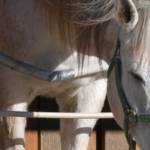Equine Recurrent Exertional Rhabdomyolysis Studied

Recurrent exertional rhabdomyolysis, also called tying-up syndrome, refers to the severe muscle cramping and cellular damage seen in some exercising horses. Various forms of tying-up affect horses of several breeds and are caused by different metabolic processes. Theories about the cause have included diet, genetics, exercise regimen, degree of fitness, and unknown disturbances in cell chemistry. This study was designed to gather information on the influence of dietary starch, fat, and bicarbonate on recurrent exertional rhabdomyolysis.
How was the study conducted?
Five Thoroughbred horses (one stallion and four mares) completed the study. The horses, all of which had a history of tying-up, rotated through three diets that provided the same amount of digestible energy (DE) from different sources. Each diet was fed for three weeks, with a fourth week being used to switch gradually to the next diet. The starch diet included pellets made from corn, wheat middlings, oats, soy meal and hulls, and molasses. This diet provided 40% of DE from starch and 5% from fat. The bicarbonate diet was the same except for supplementation with bicarbonate. Pellets in the fat diet were made from soy meal and hulls, rice bran, wheat middlings, allofat, and a pellet binder. This diet provided 7% of DE from starch and 20% from fat. Grass hay was fed to all horses.
Before the study began, the horses were exercised on a treadmill for five weeks to bring them to similar fitness levels. During the period of data collection, the horses performed treadmill exercise on weekdays and were idle on Saturdays and Sundays. The horses were confined to stalls when they were not on the treadmill.
Blood was collected immediately after each exercise period for measurement of pH, calcium, magnesium, sodium, potassium, and chloride. Another blood sample was collected four hours after exercise for the measurement of creatine kinase.
At the end of each three-week dietary period, the horses performed a standardized exercise test designed to produce near-maximal exertion. This level was determined when each horse’s heart rate was about 200 beats per minute. Gluteus muscle samples were obtained before and after this exercise test for measurement of lactate and glycogen concentrations.
What results were found?
Creatine kinase (CK) is a muscle enzyme that increases after exercise. High levels indicate that muscle damage has occurred. After daily exercise, horses consuming the starch and bicarbonate diets had post-exercise CK levels averaging almost eight times as high as horses eating the fat diet. For horses on all diets, CK levels were higher on Mondays than throughout the rest of the week, and also on days of more strenuous exercise. Diet had no significant effect on plasma lactate or muscle glycogen concentrations either before or after the standardized exercise test.
Average resting heart rate (beats per minute) was 36 for horses on the fat diet, 40 on the bicarbonate diet, and 43 on the starch diet. Heartbeat was measured while horses stood on the treadmill prior to the standardized exercise test, when rates would be expected to rise slightly in anticipation of exercise.
What do the results tell us about managing the equine diet to prevent tying-up?
The authors state that, while sample size was limited in this study, calculations performed with data from creatine kinase measurements indicated the study was valid in determining differences between dietary treatments. Several conclusions may be helpful in planning diets for horses that exhibit signs of tying-up following exercise:
• Feeding a diet that provides 40% of DE in the form of starch may lead to more exercise-induced muscle damage than when lower-starch diets are fed.
• Replacing starch with a specifically designed fat ration allows horses to continue a high-calorie intake with a decreased chance of muscle damage. Reduction in post-exercise creatine kinase may be seen in as little as a week after changing to a low-starch diet.
• While it is difficult to measure nervousness in a particular horse, heart rate may give an indication of an animal’s nervous reaction to his surroundings. Horses with nervous temperaments seem to be more susceptible to tying-up. In this study, the fat diet was associated with lower heart rates and calmer behavior, suggesting that replacing dietary starch with fat may decrease the incidence of tying-up episodes. Whether this effect is actually due to lower levels of nervousness or an unidentified neurohormonal or physiologic mechanism is unknown.
• In this study, dietary supplementation with sodium bicarbonate appeared to have no effectiveness in preventing tying-up. The authors state that bicarbonate supplementation became popular due to an erroneous belief that tying-up was related to a buildup of lactic acid in the muscles of exercising horses.
• Horses on all diets showed high creatine kinase levels when they were exercised on Mondays following two idle days. The authors state, “The successful management of (horses that experience tying up) may require feeding a high-fat, low-starch diet accompanied by an appropriate exercise regimen that does not allow excessive periods of rest or stall confinement.”
The full text of this presentation was printed in the Journal of Veterinary Internal Medicine (2003), Vol. 17, pp. 693-701.
The study “Effect of dietary starch, fat, and bicarbonate content on exercise responses and serum creatine kinase activity in equine recurrent exertional rhabdomyolysis,” was conducted by E.M. McKenzie, S.J. Valberg, S.M. Godden, J.D. Pagan, J.M. MacLeay, R.J. Geor, and G.P. Carlson.








